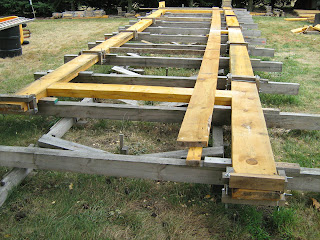Years ago when I was thinking about raising honey bees I read that if the first word that comes to mind when you hear the word "bee" is sting, than maybe raising bees might not be your thing.
Likewise, if someone was thinking about building a covered bridge I would ask them what they though of when they heard the word, jigsaw puzzle.
In this process you have to understand that each bridge truss has an inside and an outside too it. This is because of the cleats and knee bracing from the roof trusses. Also the fact that the six layers that make up each truss will be, assembled, disassembled and then re-assembled in the process. In the best case you want to ONLY handle each piece three times! This requires some thinking and planning if you are to be successful. Oh, did I mention that because of trees in the way at the bridge site the first truss would be raised to vertical from the "inside down" and the second truss from the "inside up" position?
If you look back at past posts you will see the difference. This truss requires that the cleat (piece between upper and lower chords) be placed in the first two layers, then the two layers of web and finally the pieces that make up the outside ( top and bottom) chords. This way when the truss is assembled, clamped and drilled the "inside" of the truss will be down. As layers are taken to the site this time the "outside" layers will be placed on the cribs first, leaving the final re-assembled truss "inside up". Well this should keep me busy for a week or so.

What do you do to keep it all straight? Do you have a numbering system or something?
ReplyDeleteAlso, a friend sent me this. I figure it might be something of interest to you.